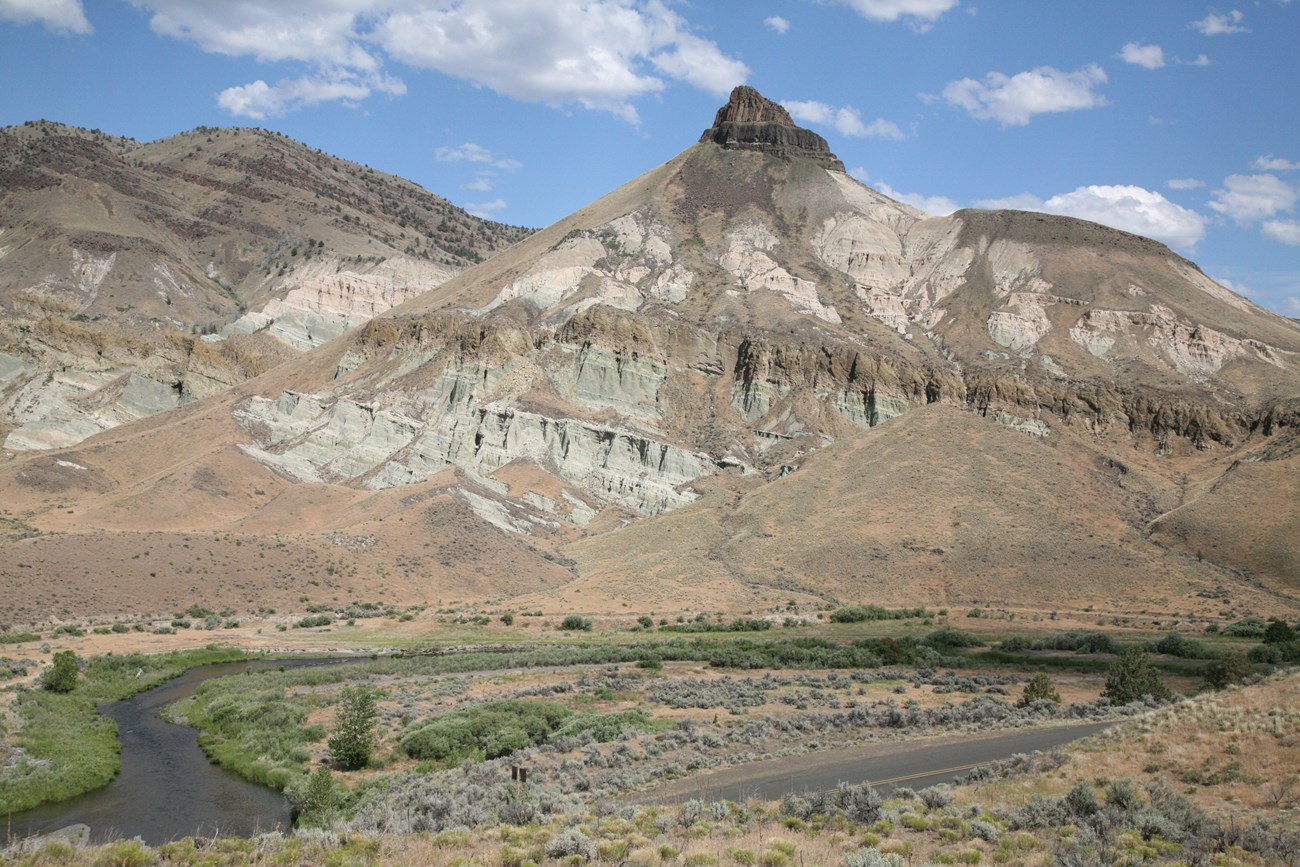Part of a series of articles titled Park Paleontology News - Vol. 14, No. 2, Fall 2022.
Article
Thirty-five-years of partnership: How the Bureau of Land Management and the National Park Service Co-manage Paleontological Resources in Eastern and Central Oregon

Nicholas A. Famoso, John Day Fossil Beds National Monument, National Park Service, Kimberly, Oregon
Beth R. Carroll, John Day Fossil Beds National Monument, National Park Service, Kimberly, Oregon
Ryan M. Griffin, Prineville District Office, Bureau of Land Monument, Prineville, Oregon
Rachel H. Falzon, John Day Fossil Beds National Monument, National Park Service, Kimberly, Oregon

NPS photo.
Introduction
Fossils of the John Day basin span 50-million years of evolution and have been of interest to U.S. and European researchers since 1865, beginning with Thomas Condon, O.C. Marsh, and E.D. Cope, later followed by J.C. Merriam, Ralph Chaney, and many others. Since then, the basin has been subdivided among a variety of landowners including the National Park Service (NPS), Bureau of Land Management (BLM), U.S. Forest Service, U.S. Fish and Wildlife, private landowners, tribal governments, and the state of Oregon. As such, co-management has been the primary means to steward the paleontological resources of the basin. The longest of these co-management partnerships has been the one between the NPS and BLM, lasting 35 years.
John Day Fossil Beds National Monument (JODA) was established in 1975 by congress as an NPS-administered site with the purpose “to preserve, and provide for the scientific and public understanding of, the geological and paleontological resources of the John Day region.” JODA was built from three Oregon state parks, BLM-administered lands, and private property that was sold to the monument within its congressional boundaries. These formed the three units of the monument: Sheep Rock, Painted Hills, and Clarno. The original monument boundaries encompassed sites with paleontological significance but excluded many. Later a boundary adjustment around the Clarno Unit added some of these sites, but plenty were and still are, on BLM-administered land.
NPS-BLM Collaboration
In 1983, an informal NPS-BLM relationship in the John Day basin started when JODA collected their first BLM fossil: an oreodont skull. It would take another four years before a formal relationship would be established in the form of a four-page interagency agreement between the NPS and BLM. The 1987 agreement gave permission for the NPS to help the BLM with field monitoring, surveying, and inventory within the John Day basin. It also authorized JODA to be a repository for any paleontological resources collected from BLM land in the John Day region. Limited in paleontologists and museum staff, the BLM relies on the NPS for support here. This agreement serves as the core for all subsequent agreements, including the current one signed in 2017.

NPS photo.
JODA paleontologists have been instrumental in identifying and raising BLM awareness of the significant and fossil rich lands, which are now protected by the John Day Paleontology Area of Critical Environmental Concern (ACEC). The ACEC includes over 31,000 acres spread across multiple BLM parcels that contain fossil exposures. Prior to the ACEC’s designation, JODA collaborated with the BLM to carefully examine hundreds of square miles of geologic exposures and measured numerous stratigraphic sections. This work provided a necessary framework against which collected fossils could be accurately mapped and dated.
Shared Resources—Shared Successes

NPS photo.
Today, JODA museum collections hold about 13,000 accessioned and/or cataloged fossils that originated on BLM-administered lands. During the 2021 and 2022 field seasons, JODA partnered with the BLM to hire, supervise, and train two BLM funded NPS museum technicians. These technicians focus on cataloging, preparing, and rehousing existing BLM fossil legacy specimens and collections at the Thomas Condon Paleontology and Visitor Center in support of public education and scientific research. Work also includes public outreach, public relations, molding and casting, collections environmental monitoring, improving data for existing cataloged BLM fossils, confirming the ownership of some existing BLM fossil specimens through land status research, and field visits to BLM localities with the NPS staff. As a part of the last two years of field work, JODA’s paleontology team collected 42 field collections in seven localities within the ACEC. The project leverages NPS JODA expertise and supervision with BLM funding to maximize outcomes for paleontological resources and the public with minimal BLM involvement. Funded work is proposed to continue for three more years, and continues to benefit BLM Prineville, Vale, Burns and Lakeview legacy collections and public education. This ongoing work carries on a tradition of support from the BLM to JODA since the late 1980s for JODA’s continued curation and storage of BLM fossil collections.
The John Day basin’s Age of Mammals and Flowering Plants story is only partially told by the fossils on NPS JODA lands. Additional pages and chapters can be found scattered across neighboring BLM-administered lands. The designation of the John Day Paleontology ACEC and JODA’s efforts have ensured that this incredible story spanning 50-million years can be told in full. Without JODA’s past and present staff, the telling of that story would be impossible.
Related Links
-
John Day Fossil Beds National Monument, Oregon—[Geodiversity Atlas] [Park Home] [npshistory.com]
Last updated: September 28, 2022
